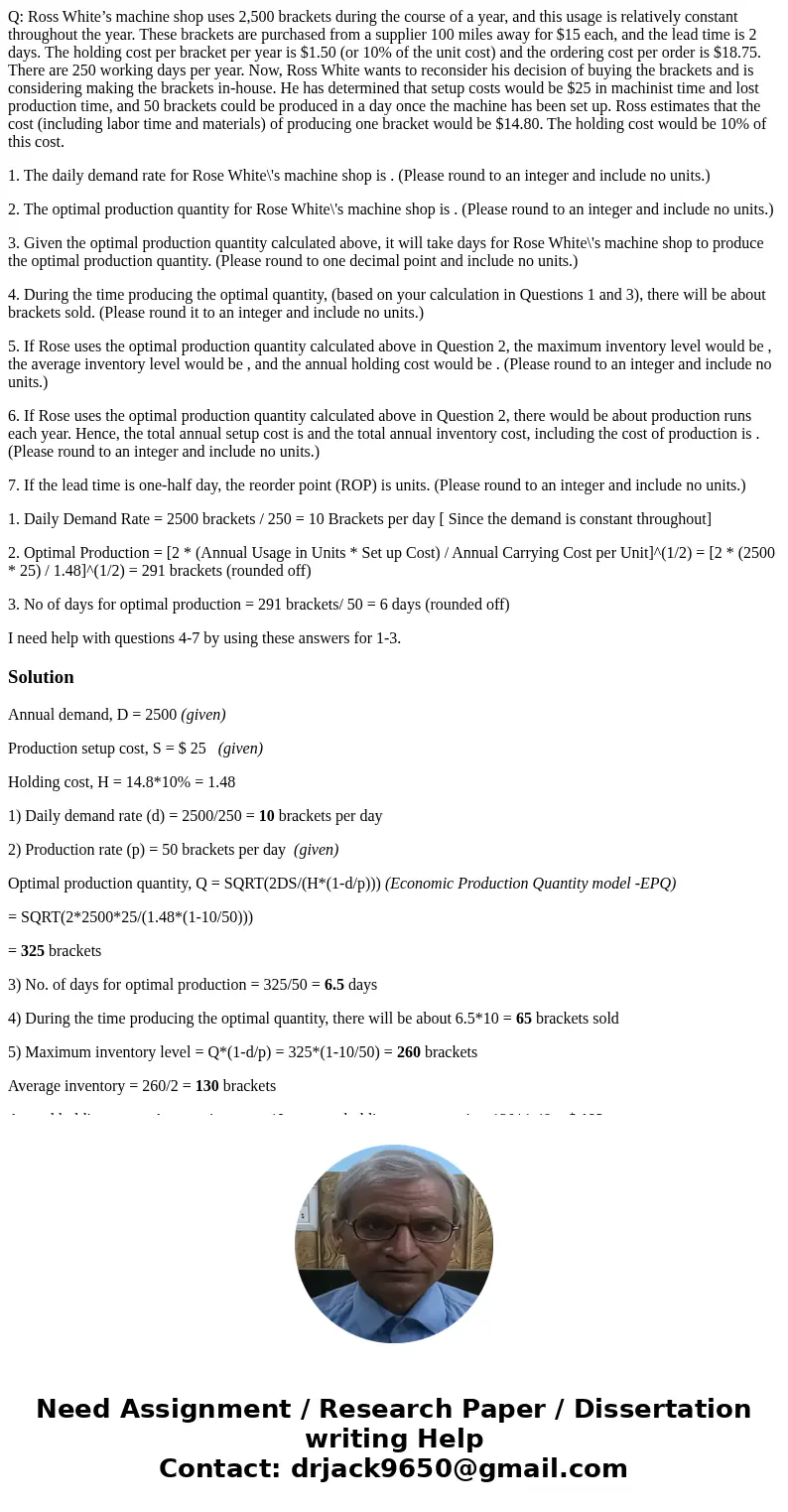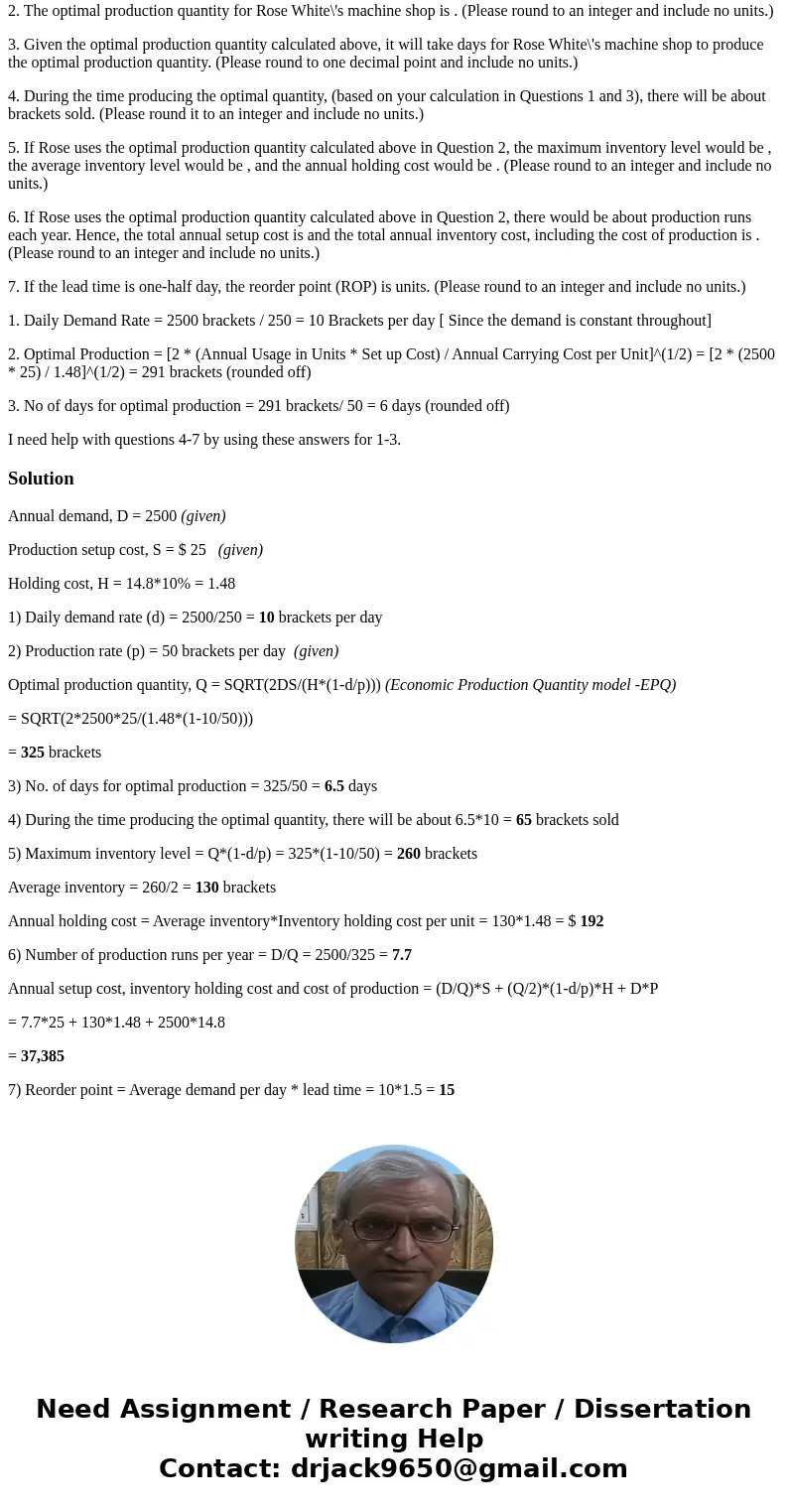Q Ross Whites machine shop uses 2500 brackets during the cou
Q: Ross White’s machine shop uses 2,500 brackets during the course of a year, and this usage is relatively constant throughout the year. These brackets are purchased from a supplier 100 miles away for $15 each, and the lead time is 2 days. The holding cost per bracket per year is $1.50 (or 10% of the unit cost) and the ordering cost per order is $18.75. There are 250 working days per year. Now, Ross White wants to reconsider his decision of buying the brackets and is considering making the brackets in-house. He has determined that setup costs would be $25 in machinist time and lost production time, and 50 brackets could be produced in a day once the machine has been set up. Ross estimates that the cost (including labor time and materials) of producing one bracket would be $14.80. The holding cost would be 10% of this cost.
1. The daily demand rate for Rose White\'s machine shop is . (Please round to an integer and include no units.)
2. The optimal production quantity for Rose White\'s machine shop is . (Please round to an integer and include no units.)
3. Given the optimal production quantity calculated above, it will take days for Rose White\'s machine shop to produce the optimal production quantity. (Please round to one decimal point and include no units.)
4. During the time producing the optimal quantity, (based on your calculation in Questions 1 and 3), there will be about brackets sold. (Please round it to an integer and include no units.)
5. If Rose uses the optimal production quantity calculated above in Question 2, the maximum inventory level would be , the average inventory level would be , and the annual holding cost would be . (Please round to an integer and include no units.)
6. If Rose uses the optimal production quantity calculated above in Question 2, there would be about production runs each year. Hence, the total annual setup cost is and the total annual inventory cost, including the cost of production is . (Please round to an integer and include no units.)
7. If the lead time is one-half day, the reorder point (ROP) is units. (Please round to an integer and include no units.)
1. Daily Demand Rate = 2500 brackets / 250 = 10 Brackets per day [ Since the demand is constant throughout]
2. Optimal Production = [2 * (Annual Usage in Units * Set up Cost) / Annual Carrying Cost per Unit]^(1/2) = [2 * (2500 * 25) / 1.48]^(1/2) = 291 brackets (rounded off)
3. No of days for optimal production = 291 brackets/ 50 = 6 days (rounded off)
I need help with questions 4-7 by using these answers for 1-3.
Solution
Annual demand, D = 2500 (given)
Production setup cost, S = $ 25 (given)
Holding cost, H = 14.8*10% = 1.48
1) Daily demand rate (d) = 2500/250 = 10 brackets per day
2) Production rate (p) = 50 brackets per day (given)
Optimal production quantity, Q = SQRT(2DS/(H*(1-d/p))) (Economic Production Quantity model -EPQ)
= SQRT(2*2500*25/(1.48*(1-10/50)))
= 325 brackets
3) No. of days for optimal production = 325/50 = 6.5 days
4) During the time producing the optimal quantity, there will be about 6.5*10 = 65 brackets sold
5) Maximum inventory level = Q*(1-d/p) = 325*(1-10/50) = 260 brackets
Average inventory = 260/2 = 130 brackets
Annual holding cost = Average inventory*Inventory holding cost per unit = 130*1.48 = $ 192
6) Number of production runs per year = D/Q = 2500/325 = 7.7
Annual setup cost, inventory holding cost and cost of production = (D/Q)*S + (Q/2)*(1-d/p)*H + D*P
= 7.7*25 + 130*1.48 + 2500*14.8
= 37,385
7) Reorder point = Average demand per day * lead time = 10*1.5 = 15


 Homework Sourse
Homework Sourse